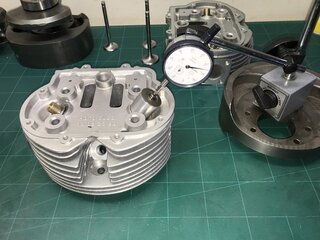I've previously set them up in the head using only the installed height figures, but I've got some beehive springs on the way, and I'll be using a press with a scale this time before installing them in the head, my plan is to try and achieve the poundage at specified height in the press using shims, but once installed in the head I can't think of a way to verify the setting. I've looked at some fancy in-head spring load gauges, but they're far too pricey and I doubt they'd even work on a brit cylinder head. Anyone have a tip they could share?
This was the query and relates to installed height to attain seated and open spring pressure, the rate of the spring should meet that requirement from the seated height.
My previous post and picture was more related to the recent post and video.
You can not set an installed height if you do not know the present distance from the under side of the retainer to the base of the lower spring cup (in a Commando or any other engine) without measuring it.
Instead of telescoping gauges as per the video all I use is a set distance piece that is shorter than the present gap, the valve collets are seated in the retainer and the dial gauge measures the valve movement when cycled.
That reading is added to the that of the distance piece for a total, that measurement is then compared to the manual installed height, if it was over measurement shimming would be an option to meet the recommended height.
That's all.
In the pic, lifting the valve will get the needed add on measurement.

The factory manual only gives a height assuming they set that to meet the spring (rate used) the poundage is worth what as information over the more relevant installed height measurement.
With the original post from 2020 if it was a cam kit with springs then an installed height would be included, the installed height would set the seated pressure, the spring rate would match that needed at full lift.
That comes back to finding the present height then meet as necessary the height recommended, workshop manual or performance spec sheet on aftermarket parts.
The stock AN springs are less than US$10 a pair so hardly going to break the bank as a replacement item at a general rebuild or restoration.
I would assume something like a JSMotorsport beehive spring set for example would have a recommended installed height (to meet specified seated and open spring pressure needed) and work within the available space (measurement) in the Norton cylinder head, perhaps with some shimming at most.
There would be little need to check that in a valve spring tester unless you did not trust the supplier and that test would be easy at any decent performance engine shop with their spring height/pressure tester.
I see now it is a Triumph post in the Commando forum.
Nothing would change and would come back to present height measurement and needed measurement not pressure.

